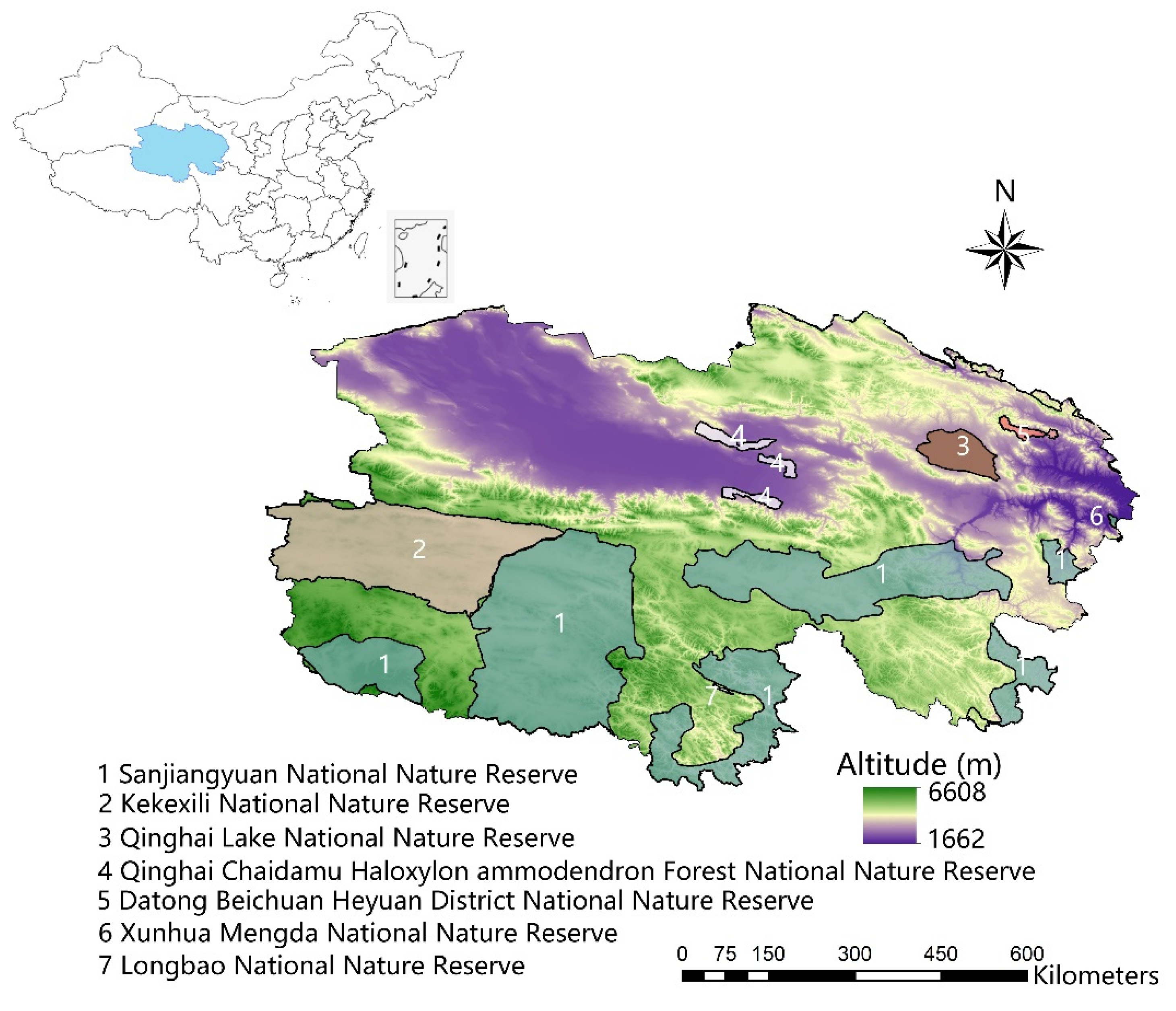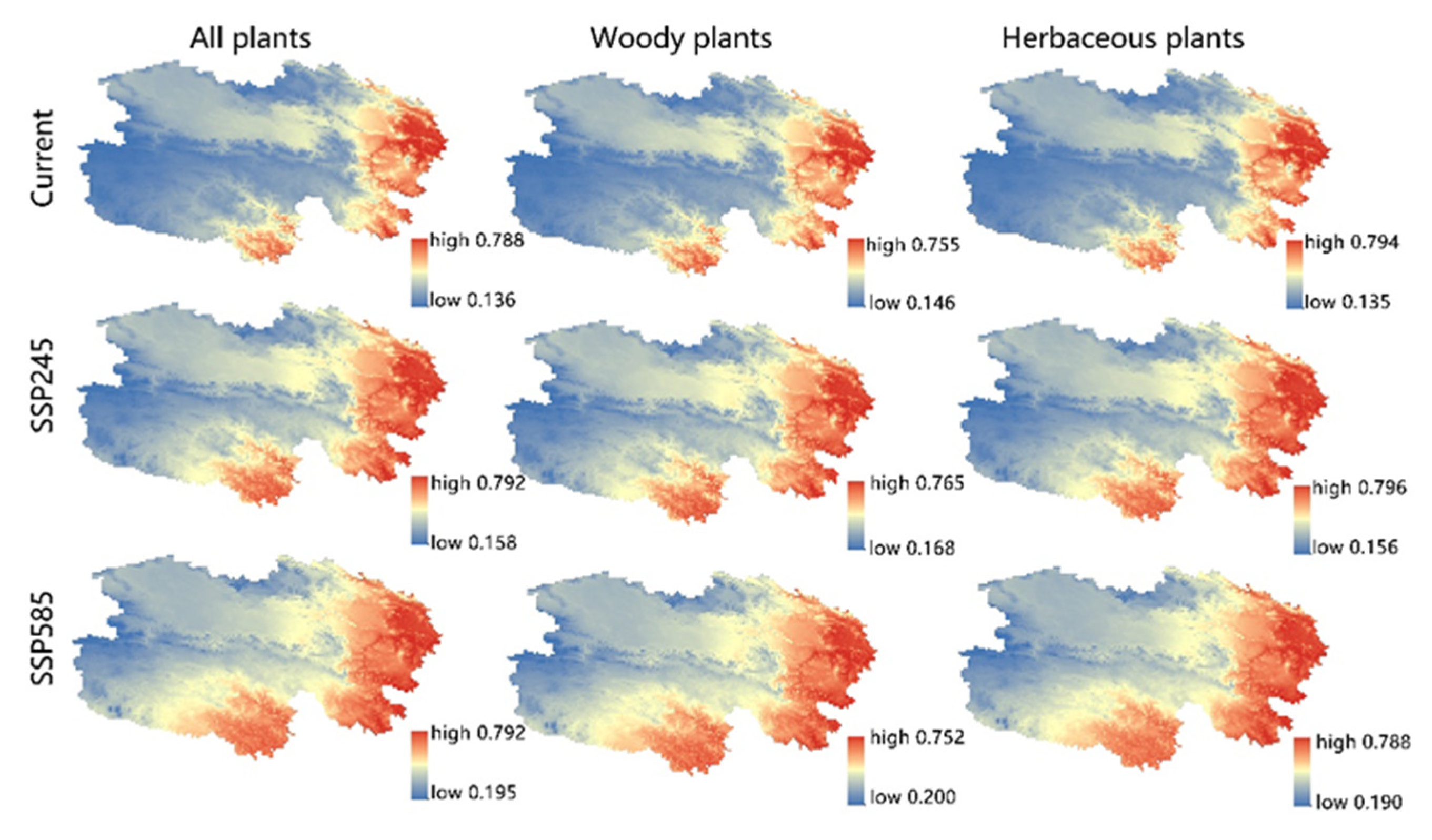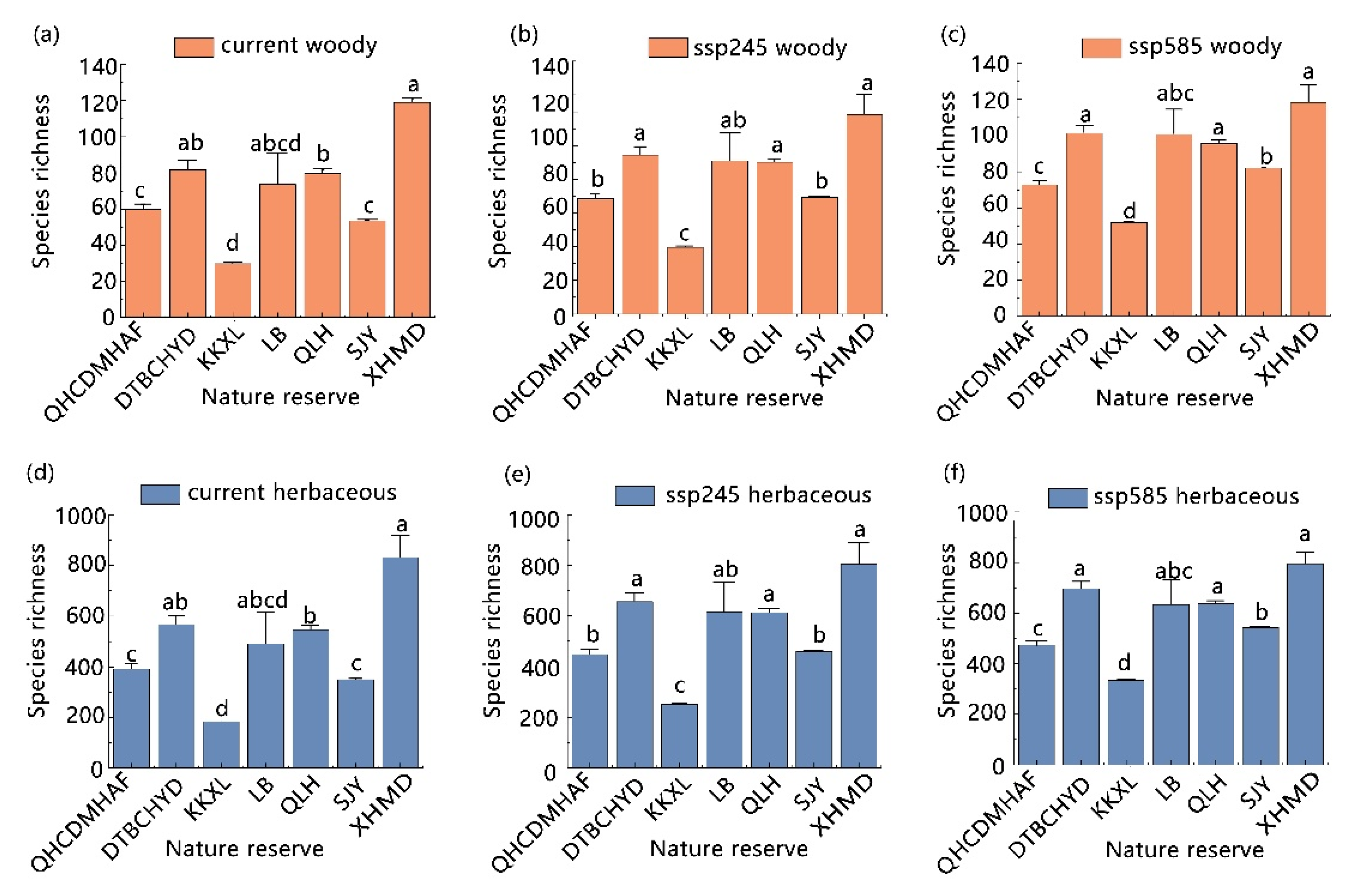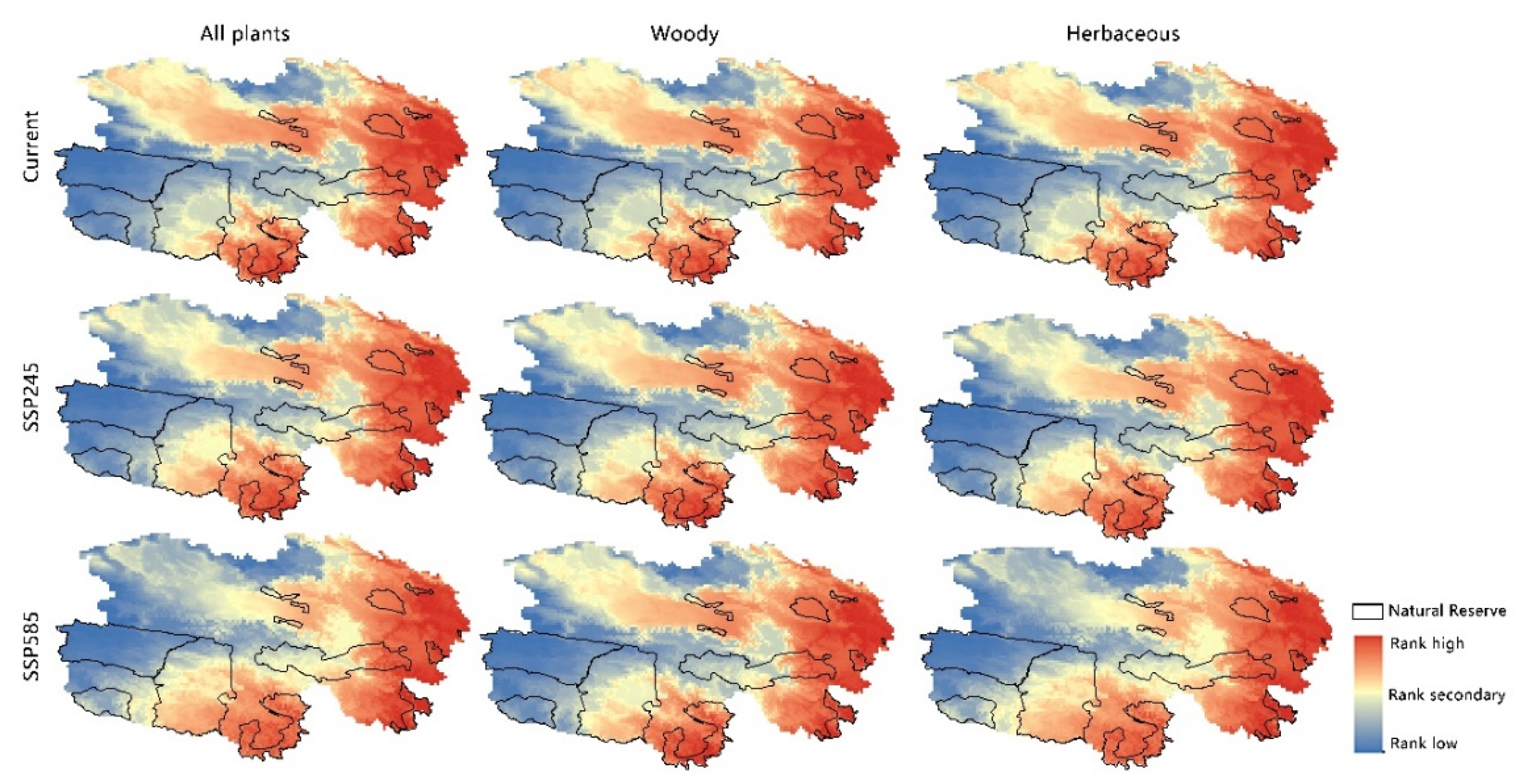Distribution and Conservation of Plants in the Northeastern Qinghai–Tibet Plateau under Climate Change
Abstract
1. Introduction
2. Materials and Methods
2.1. Study Area
2.2. Species Distribution Data
2.3. Climatic and Topographic Data
2.4. Species Distribution Model
2.5. Spatial Conservation Planning
2.6. Assessing the Ability of Nature Reserves to Protect the Richness of Plants
3. Results
3.1. Accuracy of the Species Distribution Model
3.2. Climate Change Impacts on Species Suitability Distributions
3.3. Differences in Plant Richness among Various Nature Reserves
3.4. PCAs inside and outside Nature Reserves under Climate Change
3.5. Change of Richness in PCAs
4. Discussion
5. Conclusions
Supplementary Materials
Author Contributions
Funding
Institutional Review Board Statement
Data Availability Statement
Acknowledgments
Conflicts of Interest
References
- Kim, J.Y.; Rastogi, G.; Do, Y.; Kim, D.K.; Muduli, P.R.; Samal, R.N.; Pattnaik, A.K.; Joo, G.J. Trends in a satellite-derived vegetation index and environmental variables in a restored brackish lagoon. Glob. Ecol. Conserv. 2015, 4, 614–624. [Google Scholar] [CrossRef]
- Piao, S.L.; Liu, Q.; Chen, A.P.; Janssens, I.A.; Fu, Y.S.; Dai, J.H.; Liu, L.L.; Lian, X.; Shen, M.G.; Zhu, X.L. Plant phenology and global climate change: Current progresses and challenges. Glob. Chang. Biol. 2019, 25, 1922–1940. [Google Scholar] [CrossRef]
- Prieto-Torres, D.A.; Sánchez-González, L.A.; Ortiz-Ramírez, M.F.; Ramírez-Albores, J.E.; García-Trejo, E.A.; Navarro-Sigüenza, A.G. Climate warming affects spatio-temporal biodiversity patterns of a highly vulnerable Neotropical avifauna. Clim. Chang. 2021, 165, 1–20. [Google Scholar] [CrossRef]
- Su, X.Y.; Shrestha, N.; Xu, X.T.; Sandanov, D.; Wang, Q.G.; Wang, S.Y.; Dimitrov, D.; Wang, Z.H. Phylogenetic conservatism and biogeographic affinity influence woody plant species richness-climate relationships in eastern Eurasia. Ecography 2020, 43, 1027–1040. [Google Scholar] [CrossRef]
- Peng, S.J.; Zhang, J.; Zhang, X.L.; Li, Y.Q.; Liu, Y.P.; Wang, Z.H. Conservation of woody species in China under future climate and land-cover changes. J. Appl. Ecol. 2021, 59, 141–152. [Google Scholar] [CrossRef]
- Wang, Q.; Zhang, Z.H.; Du, R.; Wang, S.P.; Duan, J.C.; Iler, A.M.; Piao, S.L.; Luo, C.Y.; Jiang, L.L.; Lv, W.W. Richness of plant communities plays a larger role than climate in determining responses of species richness to climate change. J. Ecol. 2019, 107, 1944–1955. [Google Scholar] [CrossRef]
- Zacarias, D.A. Global bioclimatic suitability for the fall armyworm, Spodoptera frugiperda (Lepidoptera: Noctuidae), and potential co-occurrence with major host crops under climate change scenarios. Clim. Chang. 2020, 161, 555–566. [Google Scholar] [CrossRef]
- Weiss, J.L.; Gutzler, D.S.; Coonrod, J.E.A.; Dahm, C.N. Seasonal and inter-annual relationships between vegetation and climate in central New Mexico, USA. J. Arid. Environ. 2004, 57, 507–534. [Google Scholar] [CrossRef]
- Workie, T.G.; Debella, H.J. Climate change and its effects on vegetation phenology across ecoregions of Ethiopia. Glob. Ecol. Conserv. 2018, 13, e00366. [Google Scholar] [CrossRef]
- Wu, C.; Venevsky, S.; Sitch, S.; Yang, Y.; Wang, M.H.; Wang, L.; Gao, Y. Present-day and future contribution of climate and fires to vegetation composition in the boreal forest of China. Ecosphere 2017, 8, e01917. [Google Scholar] [CrossRef]
- Geldmann, J.; Barnes, M.; Coad, L.; Craigie, I.D.; Hockings, M.; Burgess, N.D. Effectiveness of terrestrial protected areas in reducing habitat loss and population declines. Biol. Conserv. 2013, 161, 230–238. [Google Scholar] [CrossRef]
- Rinawati, F.; Stein, K.; Lindner, A. Climate change impacts on biodiversity the setting of a lingering global crisis. Diversity 2013, 5, 114–123. [Google Scholar] [CrossRef]
- Li, J.; Xue, Y.D.; Hacker, C.E.; Zhang, Y.; Li, Y.; Cong, W.; Jin, L.X.; Li, G.; Wu, B.; Li, D.Q.; et al. Projected impacts of climate change on snow leopard habitat in Qinghai Province, China. Ecol. Evol. 2021, 11, 17202–17218. [Google Scholar] [CrossRef] [PubMed]
- Hoffmann, S.; Irl, S.D.H.; Beierkuhnlein, C. Predicted climate shifts within terrestrial protected areas worldwide. Nat. Commun. 2019, 10, 4787. [Google Scholar] [CrossRef] [PubMed]
- Araújo, M.B.; Alagador, D.; Cabeza, M.; Nogués-Bravo, D.; Thuiller, W. Climate change threatens European conservation areas. Ecol. Lett. 2011, 14, 484–492. [Google Scholar] [CrossRef]
- Su, X.; Han, W.; Liu, G.; Zhang, Y.; Lu, H. Substantial gaps between the protection of biodiversity hotspots in alpine grasslands and the effectiveness of protected areas on the Qinghai-Tibetan Plateau, China. Agric. Ecosyst. Environ. 2019, 278, 15–23. [Google Scholar] [CrossRef]
- Xue, T.T.; Gadagkar, S.R.; Albrigh, T.P.; Yang, X.D.; Li, J.; Xia, C.Y.; Wu, J.Y.; Yu, S.X. Prioritizing conservation of biodiversity in an alpine region: Distribution pattern and conservation status of seed plants in the Qinghai-Tibetan Plateau. Glob. Ecol. Conserv. 2021, 32, e01885. [Google Scholar] [CrossRef]
- Geldmann, J.; Coad, L.; Barnes, M.D.; Craigie, I.D.; Woodley, S.; Balmford, A.; Brooks, T.M.; Hockings, M.; Knights, K.; Mascia, M.B.; et al. A global analysis of management capacity and ecological outcomes in terrestrial protected areas. Conserv. Lett. 2018, 11, e12434. [Google Scholar] [CrossRef]
- Pretty, J.; Smith, D. Social capital in biodiversity conservation and management. Conserv. Biol. 2004, 18, 631–638. [Google Scholar] [CrossRef]
- Andam, K.S.; Ferraro, P.J.; Pfaff, A.; Sanchez-Azofeifa, G.A.; Robalino, J.A. Measuring the effectiveness of protected area networks in reducing deforestation. Proc. Natl. Acad. Sci. USA 2008, 105, 16089–16094. [Google Scholar] [CrossRef]
- Margules, C.R.; Pressey, R.L.; Williams, P.H. Representing biodiversity: Data and procedures for identifying priority areas for conservation. J. Biosci. 2002, 27, 309–326. [Google Scholar] [CrossRef] [PubMed]
- Sarkar, S.; Aggarwal, A.; Garson, J.; Margules, C.R.; Zeidler, J. Place prioritization for biodiversity content. J. Biosci. 2022, 27, 339–346. [Google Scholar] [CrossRef]
- He, X.; Burgess, K.S.; Yang, X.F.; Ahrends, A.; Gao, L.M.; Li, D.Z. Upward elevation and northwest range shifts for alpine Meconopsis species in the Himalaya-Heng.duan Mountain’s region. Ecol. Evol. 2019, 9, 4055–4064. [Google Scholar] [CrossRef]
- Geppert, C.; Perazza, G.; Wilson, R.J.; Bertolli, A.; Prosser, F.; Melchiori, G.; Marini, L. Consistent population declines but idiosyncratic range shifts in Alpine orchids under global change. Nat. Commun. 2020, 11, 5835. [Google Scholar] [CrossRef] [PubMed]
- Favre, A.; Päckert, M.; Pauls, S.U.; Jähnig, S.C.; Uhl, D.; Michalak, I.; Muellner-Riehl, A.N. The role of the uplift of the Qinghai-Tibetan Plateau for the evolution of Tibetan biotas. Biol. Rev. 2015, 90, 236–253. [Google Scholar] [CrossRef]
- Zhang, D.C.; Ye, J.X.; Sun, H. Quantitative approaches to identify floristic units and centres of species endemism in the Qinghai-Tibetan Plateau, south–western China. J. Biogeogr. 2016, 43, 2465–2476. [Google Scholar] [CrossRef]
- Xing, Y.; Ree, R.H. Uplift-driven diversification in the Hengduan Mountains, a temperate biodiversity hotspot. Proc. Natl. Acad. Sci. USA 2017, 114, E3444–E3451. [Google Scholar] [CrossRef] [PubMed]
- Li, R.Q. Protecting rare and endangered species under climate change on the Qinghai Plateau, China. Ecol. Evol. 2019, 9, 427–436. [Google Scholar] [CrossRef]
- Wang, S.Z.; Zhang, Y.X.; Fan, J.W.; Zhang, H.Y. The study of diagnosis of alpine grassland condition in the Sanjiangyuan Nature Reserve. Ecol. Sci. 2022, 41, 100–109. [Google Scholar]
- Chen, H.; Zhu, Q.; Peng, C.; Wu, N.; Wang, Y.; Fang, X.; Wu, J. The impacts of climate change and human activities on biogeochemical cycles on the Qinghai-Tibetan plateau. Glob. Chang. Biol. 2013, 19, 2940–2955. [Google Scholar] [CrossRef]
- Gao, X.; Huang, X.X.; Lo, K.; Dang, Q.W.; Wen, R.Y. Vegetation responses to climate change in the Qilian Mountain Nature Reserve, Northwest China. Glob. Ecol. Conserv. 2021, 28, e01698. [Google Scholar] [CrossRef]
- Klein, J.A.; Harte, J.; Zhao, X.Q. Experimental warming causes large and rapid species loss, dampened by simulated grazing, on the Tibetan Plateau. Ecol. Lett. 2004, 7, 1170–1179. [Google Scholar] [CrossRef]
- Walker, M.D.; Wahren, C.H.; Hollister, R.D.; Henry, G.H.R.; Ahlquist, L.E.; Alatalo, J.M.; Bret-Harte, M.S.; Calef, M.P.; Callaghan, T.V.; Carroll, A.B. Plant community responses to experimental warming across the tundra biome. Proc. Natl. Acad. Sci. USA 2006, 103, 1342–1346. [Google Scholar] [CrossRef] [PubMed]
- Wang, S.P.; Duan, J.C.; Xu, G.P.; Wang, Y.F.; Zhang, Z.H.; Rui, Y.C.; Luo, C.Y.; Xu, B.; Zhu, X.X.; Chang, X.F. Effects of warming and grazing on soil N availability, species composition and ANPP in alpine meadow. Ecology 2012, 93, 2365–2376. [Google Scholar] [CrossRef]
- Sapes, G.; Serra-Diaz, J.M.; Lloret, F. Species climatic niche explains drought- induced die-off in a Mediterranean woody community. Ecosphere 2017, 8, e01833. [Google Scholar] [CrossRef]
- Merow, C.; Smith, M.J.; Silander, J.A. A practical guide to MaxEnt for modeling species’ distributions: What it does, and why inputs and settings matter. Ecography 2013, 36, 1058–1069. [Google Scholar] [CrossRef]
- Zheng, J.Y.; Ge, Q.S.; Hao, Z.X. Climate change impacts on plant phenological changes in China in recent 40 years. Chin. Sci. Bull. 2002, 47, 1582–1587. [Google Scholar] [CrossRef]
- Han, H.B.; Ma, M.G.; Ma, S.C.; Zhou, W.F.; Kang, X.Y.; Zhang, B.Y.; Zhao, H.F. Analysis of vegetation change and its climatic driving factors in Qinghai Province in recent 30 years. Arid. Zone Res. 2017, 24, 5. [Google Scholar]
- Wang, L.W.; Wei, Y.X.; Niu, Z. Spatial and temporal variations of vegetation in Qinghai Province based on satellite data. J. Geogr. Sci. 2008, 18, 73–84. [Google Scholar] [CrossRef]
- Zhang, Z.J.; He, J.S.; Li, J.S.; Tang, Z.Y. Distribution and conservation of threatened plants in China. Biol. Conserv. 2015, 192, 454–460. [Google Scholar] [CrossRef]
- Meyer, C.; Weigelt, P.; Kreft, H. Multidimensional biases, gaps and uncertainties in global plant occurrence information. Ecol. Lett. 2016, 19, 992–1006. [Google Scholar] [CrossRef] [PubMed]
- Tang, X.L.; Zhou, B.Z.; Zhou, Y.; Ni, X.; Cao, Y.H.; Gu, L.H. Photo-physiological and photo-biochemical characteristics of several herbaceous and woody species based on FvCB model. Chin. J. Appl. Ecol. 2017, 28, 1482–1488. [Google Scholar]
- Hijmans, R.J.; Cameron, S.E.; Parra, J.L.; Jones, P.G.; Jarvis, A. Very high-resolution interpolated climate surfaces for global land areas. Int. J. Climatol. 2005, 25, 1965–1978. [Google Scholar] [CrossRef]
- Estoque, R.C.; Ooba, M.; Togawa, T.; Hijioka, Y. Projected land-use changes in the Shared Socioeconomic Pathways: Insights and implications. Ambio 2020, 49, 1972–1981. [Google Scholar] [CrossRef] [PubMed]
- Elith, J.; Phillips, S.J.; Hastie, T.; Dudı, K.M.; Chee, Y.E.; Yates, C.J. Astatistical explanation of MaxEnt for ecologists. Divers. Distrib. 2011, 17, 43–57. [Google Scholar] [CrossRef]
- Li, R.Q.; Xu, M.; Wong, M.H.G.; Qiu, S.; Li, X.H.; Ehrenfeld, D.; Li, D.M. Climate change threatens giant panda protection in the 21st century. Biol. Conserv. 2015, 182, 93–101. [Google Scholar] [CrossRef]
- Phillips, S.J.; Anderson, R.P.; Dudík, M.; Schapire, R.E.; Blair, M.E. Opening the black box: An open-source release of Maxent. Ecography 2017, 40, 887–893. [Google Scholar] [CrossRef]
- Park, N.W. Using maximum entropy modeling for landslidesusceptibility mapping with multiple geoenvironmental data sets. Environ. Earth Sci. 2015, 73, 937–949. [Google Scholar] [CrossRef]
- Wan, J.Z.; Wang, C.J.; Zimmermann, N.E.; Pouteau, R.; Yu, F.H. Current and future plant invasions in protected areas: Does clonality matter? Divers. Distrib. 2021, 27, 2465–2478. [Google Scholar] [CrossRef]
- Oke, O.A.; Thompson, K.A. Distribution models for mountain plant species: The value of elevation. Ecol. Model. 2015, 301, 72–77. [Google Scholar] [CrossRef]
- Pollak, M.; Cohen, J. A comparison of the independent-samples t-test and the paired-samples t-test when the observations are nonnegatively correlated pairs. J. Stat. Plan. Inference 1981, 5, 133–146. [Google Scholar] [CrossRef]
- Driscoll, W.C. Robustness of the ANOVA and Tukey-Kramer statistical tests. Comput. Ind. Eng. 1996, 31, 265–268. [Google Scholar] [CrossRef]
- Moilanen, A.; Franco, A.M.A.; Early, R.I.; Fox, R.; Wintle, B.; Thomas, C.D. Prioritizing multiple-use landscapes for conservation: Methods for large multispecies planning problems. Proc. R. Soc. B Biol. Sci. 2005, 272, 1885–1891. [Google Scholar] [CrossRef] [PubMed]
- Lehtomaki, J.; Moilanen, A. Methods and workflow for spatial conservation prioritization using Zonation. Environ. Model. Softw. 2013, 47, 128–137. [Google Scholar] [CrossRef]
- Pawar, S.; Koo, M.S.; Kelley, C.; Ahmed, M.F.; Chaudhuri, S.; Sarkay, S. Conservation assessment and prioritization of areas in Northeast India: Priorities for amphibians and reptiles. Biol. Conserv. 2006, 136, 346–361. [Google Scholar] [CrossRef]
- Wan, J.Z.; Wang, C.J.; Han, S.J.; Wang, L.H.; Yu, J.H. The strategy for protecting threatened forest species richness in the northeastern China from the effects of climate change. Int. J. Environ. Pollut. 2019, 65, 293–310. [Google Scholar] [CrossRef]
- Wang, C.J.; Zhang, Z.X.; Wan, J.Z. Vulnerability of global forest ecoregions to future climate change. Glob. Ecol. Conserv. 2019, 20, e00760. [Google Scholar] [CrossRef]
- Seddon, A.W.; Macias-Fauria, M.; Long, P.R.; Benz, D.; Willis, K.J. Sensitivity of global terrestrial ecosystems to climate variability. Nature 2016, 531, 229–232. [Google Scholar] [CrossRef]
- Cogley, J.G. Glacier shrinkage across High Mountain Asia. Ann. Glaciol. 2016, 57, 41–49. [Google Scholar] [CrossRef]
- Weltzin, J.F.; Loik, M.E.; Schwinning, S.; Williams, D.G.; Fay, P.A.; Haddad, B.M.; Harte, J.; Huxman, T.E.; Knapp, A.K.; Lin, G.H. Assessing the response of terrestrial ecosystems to potential changes in precipitation. Bioscience 2003, 53, 941–952. [Google Scholar] [CrossRef]
- Harley, C.D. Climate change, keystone predation, and biodiversity loss. Science 2011, 334, 1124–1127. [Google Scholar] [CrossRef] [PubMed]
- Kharouba, H.M.; Vellend, M. Flowering time of butterfly nectar food plants is more sensitive to temperature than the timing of butterfly adult flight. J. Anim. Ecol. 2015, 84, 1311–1321. [Google Scholar] [CrossRef] [PubMed]
- Wan, D.S.; Feng, J.J.; Jiang, D.C.; Mao, K.S.; Duan, Y.W.; Miehe, G.; Opgenoorth, L. The Quaternary evolutionary history, potential distribution dynamics, and conservation implications for a Qinghai-Tibet Plateau endemic herbaceous perennial, Anisodus tanguticus (Solanaceae). Ecol. Evol. 2016, 6, 1977–1995. [Google Scholar] [CrossRef]
- Stewart, J.R.; Lister, A.M.; Barnes, I.; Dalen, L. Refugia revisited: Individualistic responses of species in space and time. Proc. Biol. Sci. 2010, 277, 661–671. [Google Scholar] [CrossRef] [PubMed]
- Hewitt, G. The genetic legacy of the Quaternary ice ages. Nature 2000, 88, 205–214. [Google Scholar] [CrossRef] [PubMed]
- Gavin, D.G.; Fitzpatrick, M.C.; Gugger, P.F.; Heath, K.D.; Rodriguez-Sanchez, F.; Dobrowski, S.Z.; Hampe, A.; Hu, F.S.; Ashcroft, M.B.; Bartlein, P.J. Climate refugia: Joint inference from fossil records, species distribution models and phylogeography. New Phytol. 2014, 204, 37–54. [Google Scholar] [CrossRef] [PubMed]
- Qin, W.H.; Wang, W.; Du, J.H. Vigorous desert–an investigation of Qinghai Qaidam Haloxylon ammodendron Forest National Nature Reserve. Life World 2017, 3, 34–45. [Google Scholar]
- Triviño, M.; Kujala, H.; Araújo, M.B.; Cabeza, M. Planning for the future: Identifying conservation priority areas for Iberian birds under climate change. Landsc. Ecol. 2018, 33, 659–673. [Google Scholar] [CrossRef]
- Amaral, A.G.; Bijos, N.R.; Moser, P.; Munhoz, C.B.R. Spatially structured soil properties and climate explain distribution patterns of herbaceous-shrub species in the Cerrado. Plant Ecol. 2021, 223, 85–97. [Google Scholar] [CrossRef]
- He, F.Q.; Chen, D.D.; Li, Q.; Chen, X.; Huo, L.L.; Zhao, L.; Zhao, X.Q. Temporal and spatial distribution of herbage nutrition in alpine grassland of Sanjiangyuan. Acta Ecol. Sin. 2020, 40, 6304–6313. [Google Scholar]
- Zhang, W.J.; Ye, L.Z.; Ma, B.Y.; Ma, W.W.; Hou, F.J. The response of total grassland biomass in Sanjiangyuan to future climate change scenarios. Pratac. Sci. 2021, 38, 835–847. [Google Scholar]
- Li, Y.C.; Chen, D.Y. Study on soil characteristics of periglacial environment in high altitude terrain—A case study of Hoh Xil Nature Reserve in Qinghai Tibet Plateau. Nat. Sci. 2005, 23, 947. [Google Scholar]
- Wan, J.Z.; Wang, C.J.; Qu, H.; Liu, R.; Zhang, Z.X. Vulnerability of forest vegetation to anthropogenic climate change in China. Sci. Total Environ. 2018, 621, 1633–1641. [Google Scholar] [CrossRef] [PubMed]




| Avg Contribution | Woody | Herbaceous | P |
|---|---|---|---|
| bio1 | 21.497 | 21.755 | 0.902 |
| bio4 | 7.996 | 6.926 | 0.871 |
| bio12 | 29.741 | 30.422 | 0.743 |
| bio15 | 1.456 | 2.306 | 0.166 |
| elevation | 22.747 | 25.058 | 0.351 |
| roughness | 1.987 | 2.267 | 0.677 |
| TPI | 2.131 | 2.617 | 0.353 |
| TRI | 4.262 | 3.021 | 0.112 |
| VRM | 4.252 | 3.888 | 0.648 |
| PCAs | Change Percentage (CP) | |||||||||
|---|---|---|---|---|---|---|---|---|---|---|
| Current | ssp245 | ssp585 | ssp245 | ssp245 | ssp585 | ssp585 | ||||
| Nature reserves | W | H | W | H | W | H | W | H | W | H |
| XHMD | 3 | 3 | 3 | 3 | 3 | 3 | 0.00% | 0.00% | 0.00% | 0.00% |
| DTBCHYD | 17 | 17 | 17 | 17 | 17 | 17 | 0.00% | 0.00% | 0.00% | 0.00% |
| QLH | 88 | 88 | 88 | 88 | 88 | 88 | 0.00% | 0.00% | 0.00% | 0.00% |
| LB | 2 | 2 | 2 | 2 | 2 | 2 | 0.00% | 0.00% | 0.00% | 0.00% |
| SJY | 537 | 537 | 593 | 537 | 593 | 608 | 10.43% | 0.00% | 10.43% | 13.22% |
| QHCDMHAF | 36 | 36 | 31 | 36 | 31 | 19 | −13.89% | 0.00% | −13.89% | −47.22% |
| KKXL | 0 | 0 | 0 | 0 | 0 | 0 | 0.00% | 0.00% | 0.00% | 0.00% |
| TCINR | 683 | 683 | 734 | 683 | 734 | 737 | 7.47% | 0.00% | 7.47% | 7.91% |
| TCONR | 2315 | 2315 | 2264 | 2315 | 2264 | 2261 | −2.20% | 0.00% | −2.20% | −2.33% |
| Lifestyle | Richness of PCAs | |
|---|---|---|
| current | Herbaceous | 472.007 |
| Woody | 70.294 | |
| All species | 542.301 | |
| ssp245 | Herbaceous | 552.124 |
| woody | 82.785 | |
| All species | 634.909 | |
| ssp585 | herbaceous | 606.152 |
| woody | 90.090 | |
| All species | 696.242 |
Publisher’s Note: MDPI stays neutral with regard to jurisdictional claims in published maps and institutional affiliations. |
© 2022 by the authors. Licensee MDPI, Basel, Switzerland. This article is an open access article distributed under the terms and conditions of the Creative Commons Attribution (CC BY) license (https://creativecommons.org/licenses/by/4.0/).
Share and Cite
Zhang, F.-X.; Yang, L.-H.; Wang, C.-J.; Zhang, C.-H.; Wan, J.-Z. Distribution and Conservation of Plants in the Northeastern Qinghai–Tibet Plateau under Climate Change. Diversity 2022, 14, 956. https://doi.org/10.3390/d14110956
Zhang F-X, Yang L-H, Wang C-J, Zhang C-H, Wan J-Z. Distribution and Conservation of Plants in the Northeastern Qinghai–Tibet Plateau under Climate Change. Diversity. 2022; 14(11):956. https://doi.org/10.3390/d14110956
Chicago/Turabian StyleZhang, Fei-Xue, Ling-Hua Yang, Chun-Jing Wang, Chun-Hui Zhang, and Ji-Zhong Wan. 2022. "Distribution and Conservation of Plants in the Northeastern Qinghai–Tibet Plateau under Climate Change" Diversity 14, no. 11: 956. https://doi.org/10.3390/d14110956
APA StyleZhang, F.-X., Yang, L.-H., Wang, C.-J., Zhang, C.-H., & Wan, J.-Z. (2022). Distribution and Conservation of Plants in the Northeastern Qinghai–Tibet Plateau under Climate Change. Diversity, 14(11), 956. https://doi.org/10.3390/d14110956






